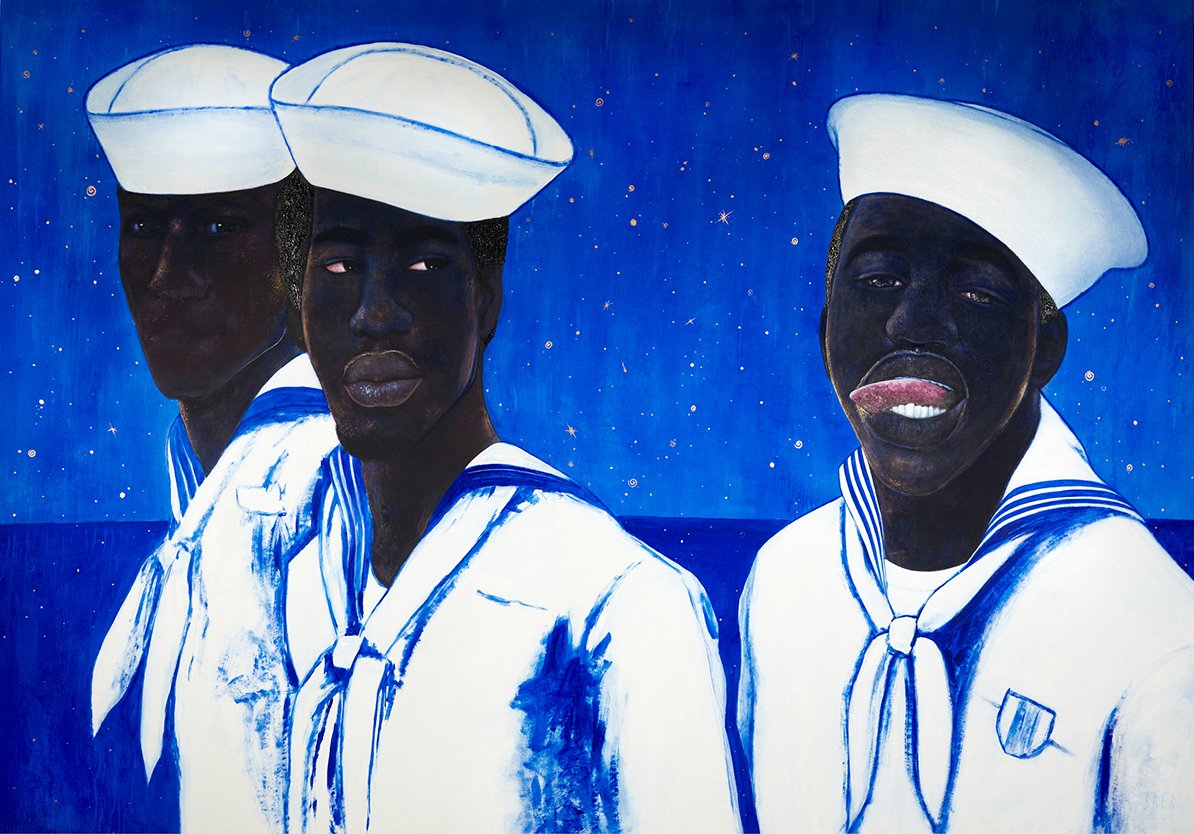
Brendon Reis, “Couple Breeze” (2021)
“This painting is inspired by a famous photograph called ‘Three Navy Sailors’ (1969–72) by Alvin Baltrop, taken after a few Black sailors got off a ship,” says Good Black Art founder Phillip Collins. “It’s one of my favorite photos of all time. I’m fascinated by the queer Black experience before the AIDS epidemic.”
When describing the impetus for Good Black Art—a platform for buying from, discovering, and mentoring emerging Black artists—its founder, Phillip Collins, harkens back to his days growing up Black and queer in Kingsport, Tennessee. With a population of fewer than 60,000, which is 90 percent white and roughly 3.5 percent Black, Collins lived as an outsider in his hometown. He moved to North Carolina to study at Elon University’s Martha & Spencer Love School of Business, and after graduating, boarded a plane for Shanghai and started what would become a near-decade-long career running communications for some of the world’s biggest brands, including American Express, G.E., Ford, and Disney. “Shanghai is where my world really opened up,” Collins says, who has also lived and worked in Brazil, Europe, Asia, and the Middle East. But in 2017, after nearly a decade abroad, he began to feel incomplete and stifled, and longed to be closer to his family and his culture. He decided to return to the United States.
Collins’s experience following his homecoming, marked by professional difficulties and personal triumphs, introduced him to the challenges of being Black in the predominately white work environs of corporate America. And yet, he remained determined to chart his own path. “I came to New York, and immediately everything I ran away from when I was 22 came back: the homophobia, the racism,” he says. “I was very unhappy.”
During his tribulations, Collins found himself turning to art as a source of inspiration, as it gave him a sense of belonging in the world. He began collecting, often discovering and DMing with artists on Instagram, and has since amassed an ever-growing personal compendium of more than 150 works by emerging Black artists from around the globe. For Collins, collecting art was healing and transformative, and ignited a hidden passion he had to create spaces to tell Black stories, like his.
The activity also revealed a lack of guidance for the artists he championed, who, Collins discovered, often found their industry opaque and difficult to navigate. They had long needed support—from pricing their work to getting it in front of collectors—that he was uniquely positioned to offer. So Collins channeled his energy, and the lessons he learned through collecting, into Good Black Art, which he started in the summer of 2021 to aid up-and-coming Black artists and collectors in moving through the commercial art world.
A multifaceted resource, the platform features three pillars of engagement for users. Its global network provides direct-to-consumer sales, in-person and virtual exhibitions hosted at Collins’s SoHo home and at galleries throughout New York City, and an ongoing series of articles and videos, called Good Talks, that delve into the lives of artists and their respective practices. Collectors receive a Collector’s Kit, filled with the essentials to protect one’s artworks: gloves, a measuring tape, a carpenter’s pencil, a level. “I want to help other budding collectors on their collecting journeys avoid the same mistakes I made,” Collins says. “It’s important to use these items in protecting the value of the physical artworks. In doing so, and more importantly, this protects the narratives these artworks represent.”
Many of the artists mentored by Good Black Art, including PJ Harper, Mario Joyce, and Adrian Armstrong, have seen their stars rise swiftly. Such momentum will likely continue this year: “Molded,” an exhibition of culturally significant mediums that blur the lines between art and design, is on view at the design studio TRNK’s Tribeca showroom through February 28, and programming tied to art fairs in March, April, and May is in the works.
Creating Good Black Art, Collins says, is how he can have the most impact. (He credits much of his feelings of responsibility toward others to watching a MasterClass episode in 2020, in which the award-winning producer, actress, and writer Issa Rae shared her views on the obligations we all share to help those around us if we have the tools to do so.) We recently asked Collins to share key pieces from his collection that led him to launch the platform. For the artworks pictured, Collins explains the significance of each object, and in doing so, reveals a source of the knowledge that informs his efforts today.
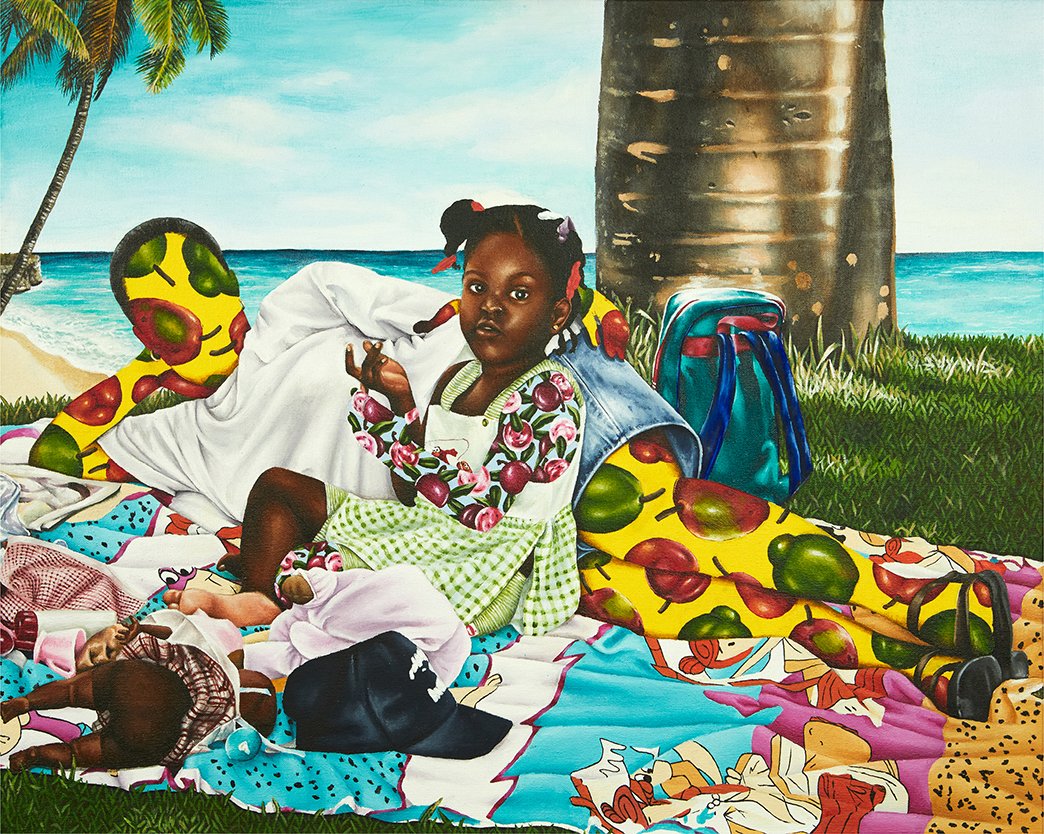
Akilah Watts, “Picnic in Paradise” (2021)
“I love that Akilah Watts represents the Caribbean in a fresh and modern way on her own terms,” Collins says. “I was immediately struck by her technique and detail. There are so many amazing artists that are coming from that region, like April Bey and Jeffrey Meris, who are redefining Caribbean art.”
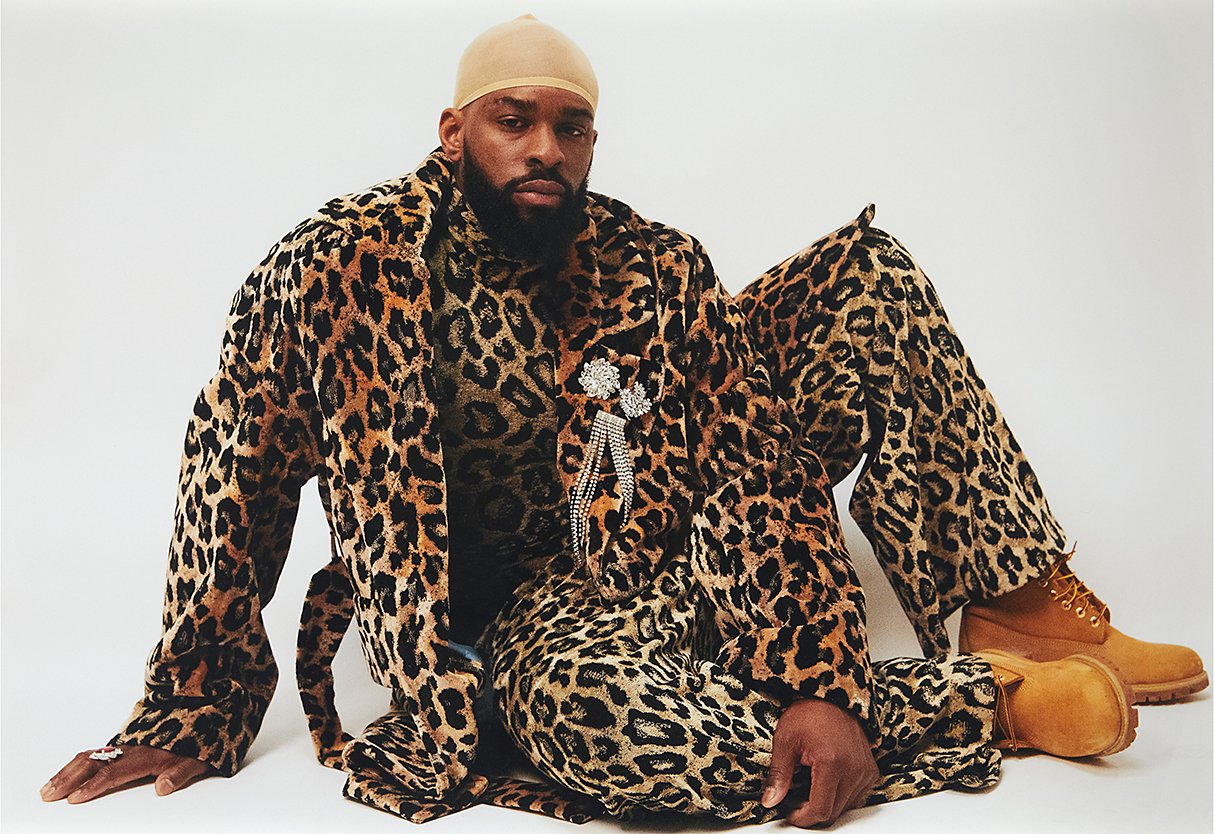
Stéphane Gaboué, “Casting Call I” (2021)
“This work conveys contradictions. Stéphane Gaboué’s work is always hot and cold. It’s feminine, but masculine,” Collins says. “A Black man in Tims, a leopard print, and big gold jewelry is quite unusual. In my life, I grapple with the fact that there are two sides to everything. Instead of choosing one side, I wonder, How do we exist in multitudes?”
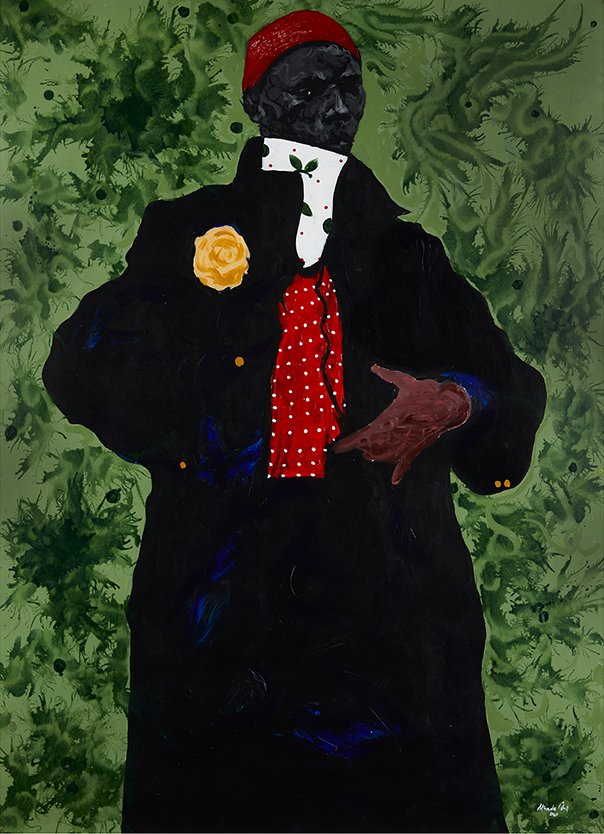
Atanda Quadri Adebayo, “Classic Man II” (2021)
“When I first connected to this body of work, I was immediately struck by the stature of the figures,” Collins says. “When I saw this piece, I was going through a period of self-doubt and having challenges regarding my worth. Now I have it in front of my bed, and every morning I look at it and remember who I am.”
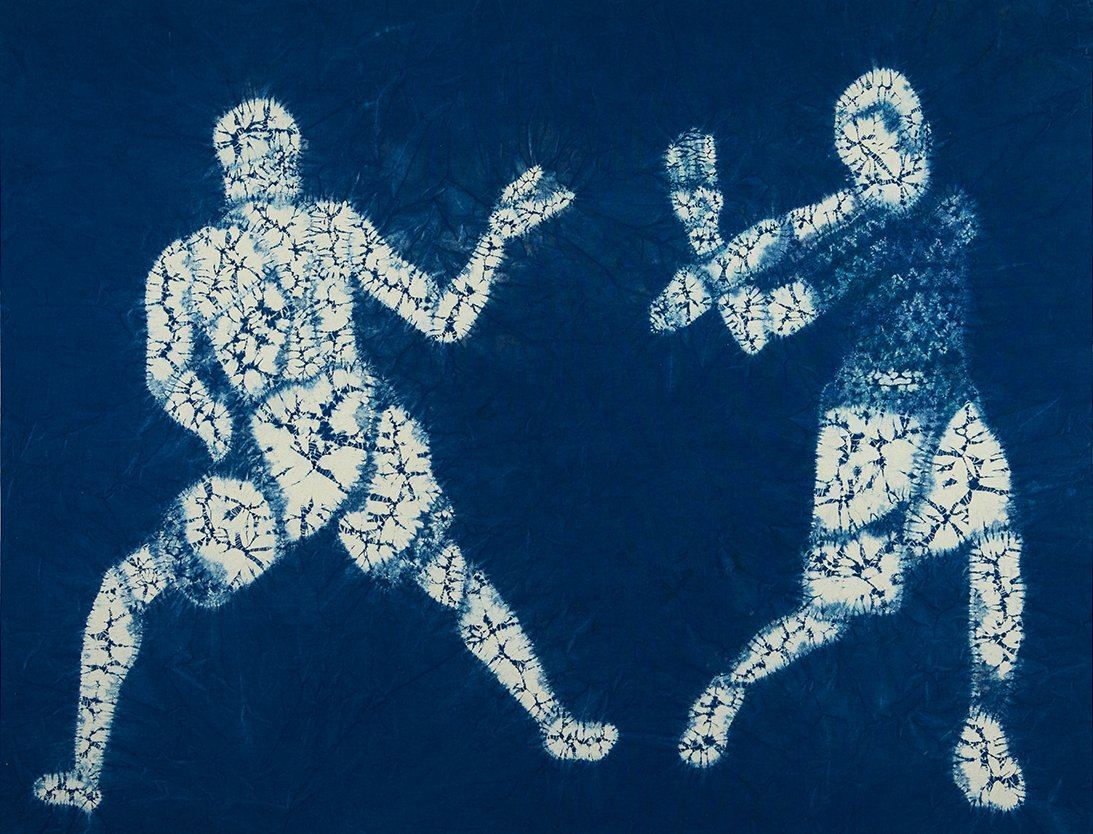
Atanda Quadri Adebayo, “Classic Man II” (2021)
“When I met Bakari, we had such an amazing conversation about humanity,” Collins says. “He has a calmness, a spiritual way of speaking. His work transcends different cultures because he takes ideas from so many places to tell his story. He’s taken a lot of techniques from Indonesia and South Korea with his use of indigo.”
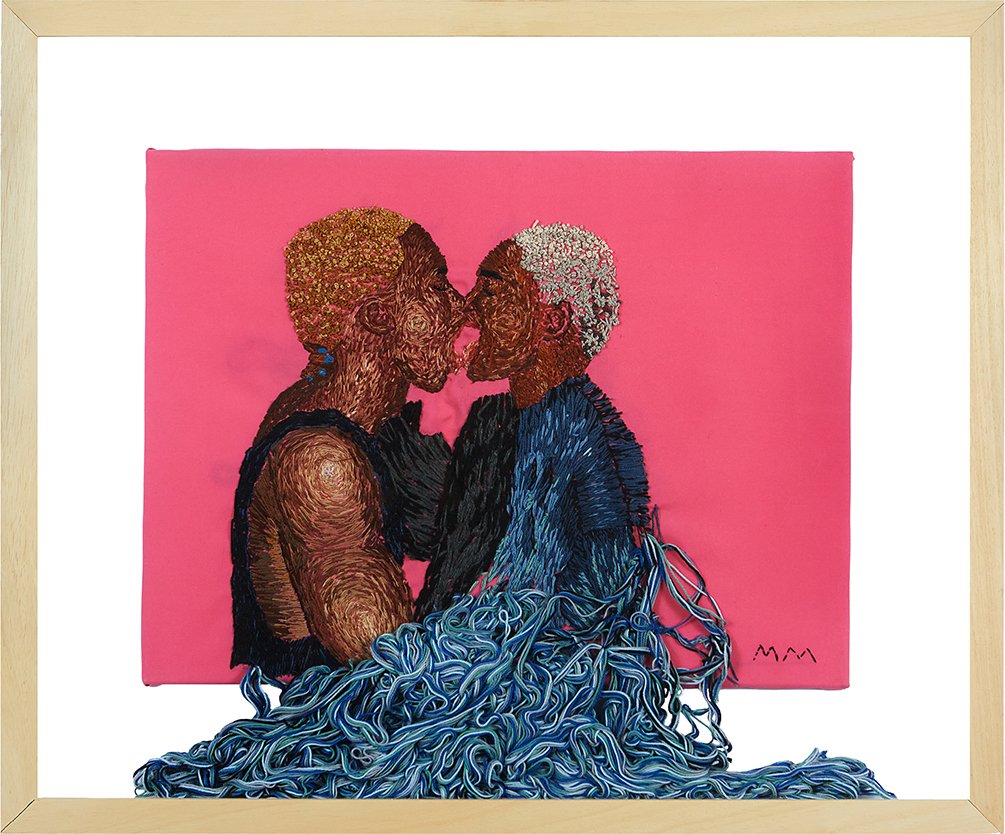
Muofhe Manavhela, “James 4:12” (2017)
“The story behind the work is about two young men in the artists’ school in South Africa who were essentially expelled for kissing,” Collins says. “I was immediately attracted to this piece—I love the use of material. I’d never seen an embroidered canvas with such a dramatic drape before. It’s about four feet long.”
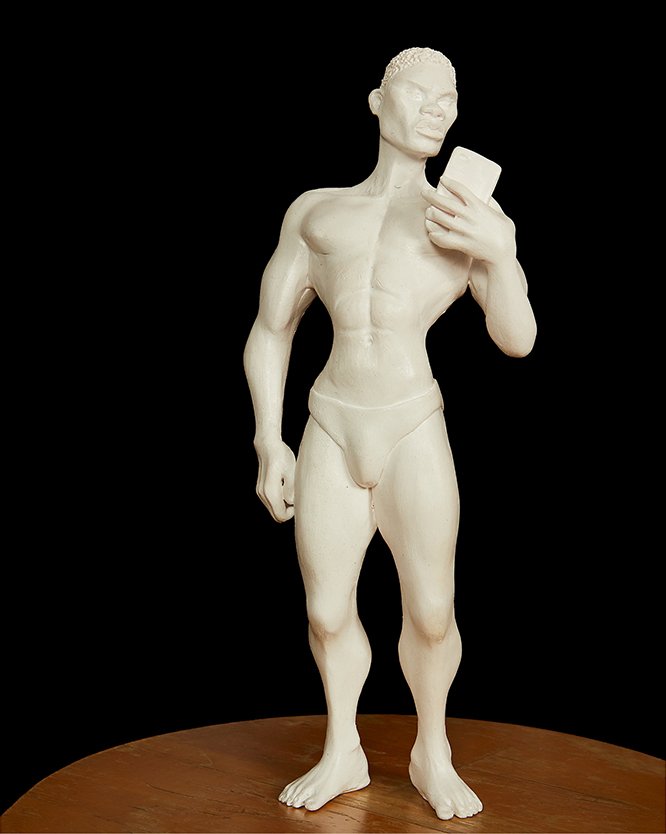
PJ Harper, “Statue of Paddy” (2019)
“When I first saw this work, I knew the artist had formal knowledge of the human body,” Collins says. “But I also thought it was a prototype: There’s a rawness to it that looks unfinished. For me, this piece exemplifies understanding the creative process, and respecting the process by being patient as things grow.”
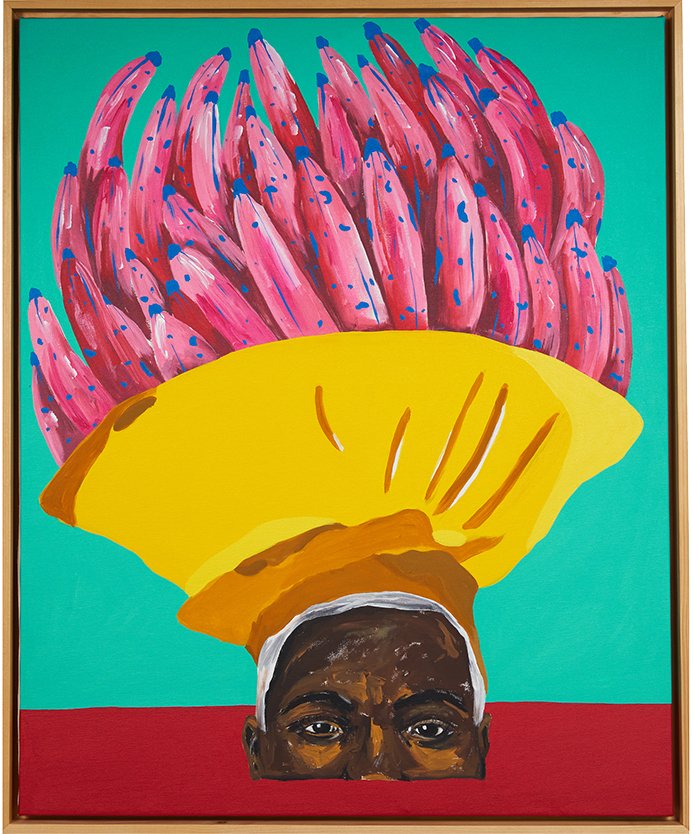
Zéh Palito, “Suffering and Smiling” (2019)
“Derrick Adams introduced me to Zéh Palito. I love this work because it’s a great way to show his view of the world,” Collins says. “It’s colorful and it’s optimistic. He’s always looking at the bright side of things. It was the first piece that I ever brought that was unstretched.”
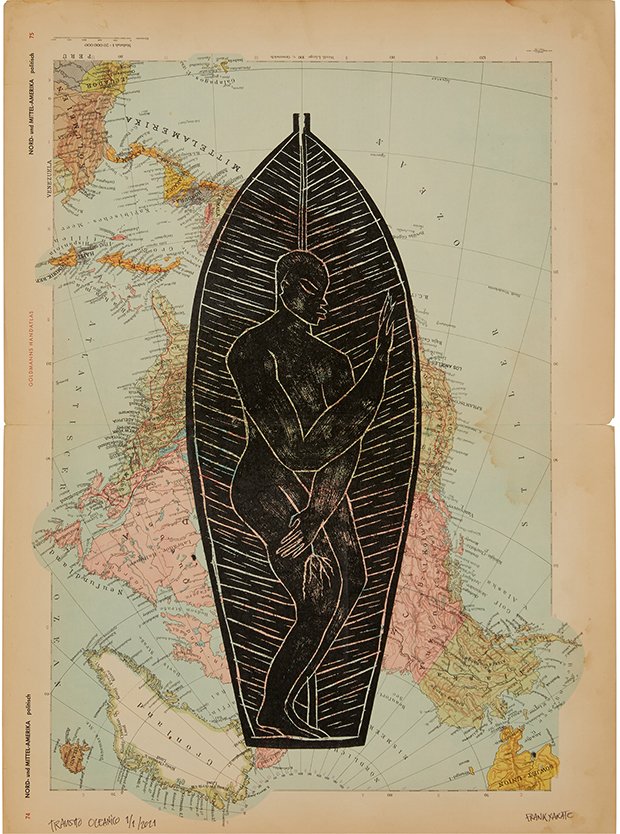
Frank Xarate, “Oceanic Transit I” (2021)
“This piece tells the story of our ancestors coming from Africa. Frank is based in Buenos Aires and is originally from a part of Colombia where there are no opportunities for artists,” Collins says. “What’s fascinating about Frank is his connection to his ancestry and his spirituality. Most of his works come to him in the form of a dream.”

Mario Joyce, “I Swam Across the Atlantic” (2020)
“Very rarely do I see a piece or a body of work without knowing the artist and understanding who the artist is,” Collins says. “With both Mario and I growing up in rural white spaces as queer Black men, I understood it. It has such a connection to nature and tells the story of our transit.”